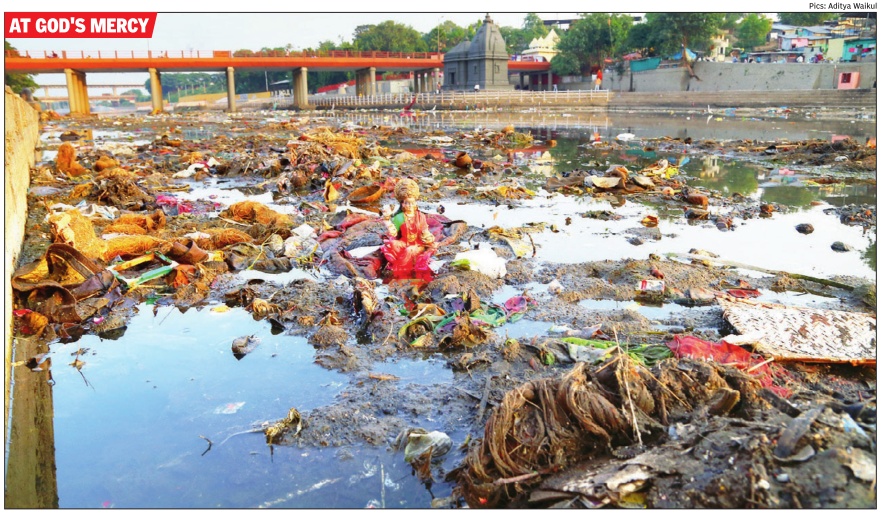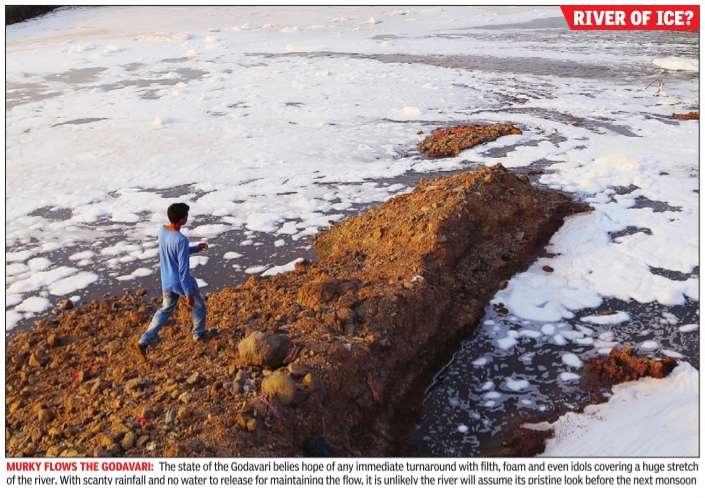River Godavari
This is a collection of articles archived for the excellence of their content. |
Pollution
Preventing pollution, garbage
Sumita Sarkar, In holy city, Godavari gets 24x7 security, Sep 18, 2017: The Times of India

Nashik Takes Steps To Check Pollution, But Concrete Layer on Riverbed Remains Vexed Problem
As a group of boys frolic in the Go davari in Nashik, a guard, standing on the bank, blows a whistle to warn them against throwing anything into the river.
He is among the 52 Maharashtra Security Guards Board personnel deployed 24x7 along a 3.5km stretch of the river.They do not even let vendors dip vegetables in the water or local residents wash clothes or vehicles in it. In partnership with The Nashik Municipal Corporation started providing security to the river in April following a Bombay high court directive in response to a PIL to check river pollution. Between April 1 and September 14, at least 42 persons have been slapped with a fine of Rs 1,000 each for polluting the river.
The guards are stationed between Ramkund, a bathing ghat that's the epicentre of the Kumbh Mela, and Tapovan. The stretch sees a huge number of devotees and tourists.
It was in 2013 that the court directed deployment of police along the banks. The order was implemented for some time before policemen were withdrawn due to a manpower crunch.
Rajesh Pandit, an activist who filed the PIL in 2012, said, “In 2014, the court ordered installing of nets below the bridges to stop filth from falling into the river. The NMC has started doing that only now.“
Ahead of the 2015 Kumbh, authorities cleaned the river.But soon after, it was back to square one (see graphic). So, this April, the civic body deployed guards. One of them, Bhagwan Sonawane, said, “Only immersion of ashes of the dead is done in a small pond inside Ramkund now. The condition of the river is better than when we started work.“ Other guards say it's a challenging job and arguments with devotees and threats from locals have become routine.
Activists say this exercise is not enough because there's also the problem of untreated sewage entering the river, and concreting of the riverbed.
Nashik divisional commissioner Mahesh Zagade has asked for a sewage audit from Gangapur to Nandur Madhyameshwar dam because drainage and stormwater drains are linked in many places.
UB Pawar, a city engineer, said less than 1km of the riverbed has been concretised in the last 48 years. According to him, the riverbed was concretised for the safety of the devotees because they could get injured if there was silt.
However, activist Devang Jani said, “It's strange to concretise the riverbed here. Kumbh Mela is held at the confluence of the Aruna and the Godavari.Removing the concrete would ensure the river's natural flow with its live springs. They are now buried under the concrete.“
About the future, Nashik municipal commissioner Abhishek Krishna says the civic body would take more steps to clean the river. “The state has approved augmentation of the drainage network and laying of new pipelines. This will ensure that only treated water enters it,“ he said.
2015: Status after the Kumbh
The Times of India, Nov 23 2015


Sumita Sarkar
Kumbh over, no one cares for Godavari
Two months since the Godavari was cleaned, the river is back to being a murky nullah choked with household waste, plastic and puja material dumped into it Two months since the G o d ava r i w a s cleaned for the Kumbh Mela in Nashik, the river is back to being a murky nullah choked with garbage of all sorts -household waste, plastic and puja material dumped into it during the recent festive period. Residents have resumed washing clothes on the banks of the river, which has lost its usual placid flow after the Kumbh Mela, Navaratra, Diwali and the most-recent Chhath Puja.The new ghats, which were constructed for the 12-yearly religious congregation, have become dirty , a striking contrast to what it was a few months ago.
During the Kumbh Mela, water was released from the upstream dams to ensure that the river was periodically washed. But with scanty rainfall this monsoon and no water to release for maintaining the river's flow, it is unlikely that the Godavari will assume its pristine look before the onset of the next rainy season.
The Nashik Municipal Corporation (NMC) had put in months of hard work and planning to prepare the river ghats for the biggest religious congregation of the world hosted in the city every 12 years. After the event, the civic body seems to have lost its diligence and vigour, with one major consequence: the Godavari has become a murky nullah with foam, filth, plastic, used puja material and other garbage swirling in it.
“Washing vehicles has reduced but solid waste disposal and washing of clothes continue to pollute the river. The tributaries, particularly Nasardi, Kaplia and Waldevi, are the worst polluted,“ said green activist Rajesh Pandit.
This is not to say that littering and pollution had completely ceased during the Mela. Even during the event, foam formation was seen on one side of the Sangam bridge, and filthy water from the Nasardi met the Godavari on the other side of the ghats.
The NMC had installed a net on the view from the bridge to conceal the murky water from the view of the pilgrims. The net has been removed ever since.
During a hearing on the Godavari pollution, the Bombay high court last month observed that the river had become dirty after the Mela.The HC observed this in response to a September 5 letter addressed by the executive engineer, irrigation division to the district collector, requesting him to release water from the Gangapur dam for cleaning and washing away the filth accumulated in the river during the Kumbh Mela.
But scanty rainfall in 2015 induced the government to redirect a major share of the dam waters to the parched Marathwada. And the river now has no means to wash away the garbage and rejuvenate its natural chemical and oxygen levels.
Pandit had filed a PIL against some government officials for being responsible for river pollution. Based on the HC's directions and National Environmental Engineering Research Institute's (NEERI) recommendations, the NMC made some permanent and temporary arrangements to arrest the pollution during the Kumbh.
NEERI is now working on the problem in collaboration with IIT-Powai to bring down the bio-chemical oxygen demand (BOD) of the outlets of the sewage treatment plants (STPs). “The BOD of the STPs is in accordance with the specifications of the centre.But since the sewage water is not treated completely , NEERI suggested that it be brought down and they are working on it,“ said UB Pawar, the superintending engineer of the NMC's sewage department.
“The foam formation is our original problem but it is just an aesthetic issue. The increase in the foam formation is due to season change,“ he added. “The NMC put up boards all over the banks and bridges to prevent river pollution, has done phytorid treatment for water purification at Someshwar nullah, diverted the sewage released in the nullahs to the STP plants permanently and in two places -Anandwalli and Lendi nullas, temporary diversion has been done,“ Pawar said.
An official in the NMC's health department said the problem of unclean ghats would soon be solved as they sought the general body's approval for outsourcing the sanitation work to 700 people. “At present, we have only 40 sanitary workers in Ramkund and the surrounding areas. We have 1,500 sanitary employees and the requirement is 4,500,“ he said.
And as long as the wait for the staffers, water and prohibitions continues, Godavari flows in whatever way it can.
WATER QUALITY
MPCB collected water samples from Ramkund, Tapovan, Takli Sangam and Dasak in Nashik & Kushawarth, Ahilya Sangam and Bada Udasin Akhada in Trimbakeshwar during Kumbh BOD was found between 3 and 9 mg per litre on an average Dissolved oxygen was found to be between 3 and 6 mglitre on an average, recommended level is 5 mglitre NEERI director Rakesh Kumar said the BOD should be below 3 mglitre for bathing If there has been 10-time dilution of water, then it is fine
COURT CONCERN
From December 6, 2012 till October 29, 2015, the Bom bay HC issued several direc tions to curb river pollution. In its latest order after the Kumbh, the HC observed that the river has once again become dirty and appointed NEERI again to study and suggest long-term and immediate solutions to check the pollution of the river.